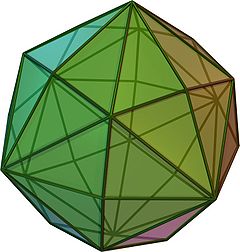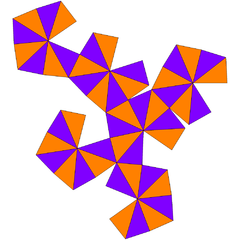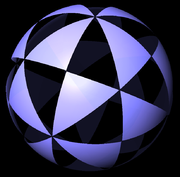- Disdyakis dodecahedron
-
Disdyakis dodecahedron 
Click on picture for large version
Spinning version
Type Catalan Face polygon scalene triangle Faces 48 Edges 72 Vertices 26 = 6 + 8 + 12 Face configuration V4.6.8 Symmetry group Oh, [4,3], *432 Dihedral angle 155° 4' 56"

Dual polyhedron truncated cuboctahedron Properties convex, face-transitive 
NetIn geometry, a disdyakis dodecahedron, or hexakis octahedron, is a Catalan solid and the dual to the Archimedean truncated cuboctahedron. As such it is face-transitive but with irregular face polygons. It looks a bit like an inflated rhombic dodecahedron—if one replaces each face of the rhombic dodecahedron with a single vertex and four triangles in a regular fashion one ends up with a disdyakis dodecahedron. More formally, the disdyakis dodecahedron is the Kleetope of the rhombic dodecahedron.
Contents
Symmetry
It has Oh octahedral symmetry. Its collective edges represent the reflection planes of the symmetry.


Dimensions
If its smallest edges have length 1, its surface area is
 and its volume is
and its volume is  .
.See also
- Disdyakis triacontahedron
- Bisected hexagonal tiling
- Great rhombihexacron—A uniform dual polyhedron with the same surface topology
References
- Williams, Robert (1979). The Geometrical Foundation of Natural Structure: A Source Book of Design. Dover Publications, Inc. ISBN 0-486-23729-X. (Section 3-9)
- The Symmetries of Things 2008, John H. Conway, Heidi Burgiel, Chaim Goodman-Strass, ISBN 978-1-56881-220-5 [1] (Chapter 21, Naming the Archimedean and Catalan polyhedra and tilings, page 285, kisRhombic dodecahedron )
External links
- Eric W. Weisstein, Disdyakis dodecahedron (Catalan solid) at MathWorld.
- Disdyakis Dodecahedron (Hexakis Octahedron) Interactive Polyhedron Model
Polyhedron navigator Platonic solids (regular) Archimedean solids
(Semiregular/Uniform)Catalan solids
(Dual semiregular)triakis tetrahedron · rhombic dodecahedron · triakis octahedron · tetrakis cube · deltoidal icositetrahedron · disdyakis dodecahedron · pentagonal icositetrahedron · rhombic triacontahedron · triakis icosahedron · pentakis dodecahedron · deltoidal hexecontahedron · disdyakis triacontahedron · pentagonal hexecontahedronDihedral regular Dihedral uniform Duals of dihedral uniform Dihedral others Degenerate polyhedra are in italics. 
This polyhedron-related article is a stub. You can help Wikipedia by expanding it.
